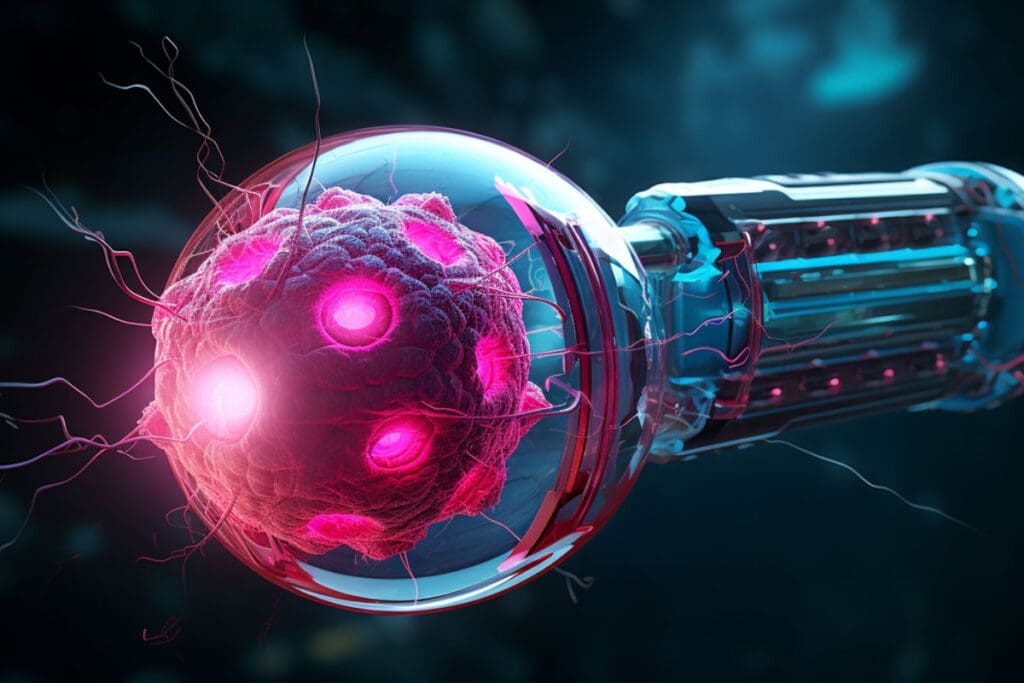
In a groundbreaking technique, scientists employed a novel method of causing molecules to vibrate to fight cancer. They destroyed 99% of cancer cells. Could this be the future of cancer treatment?
Scientists Use Vibrating Molecules to Destroy 99% of Cancer Cells
In bioimaging, aminocyanine molecules are commonly used as synthetic dyes. The molecules are used in low doses to detect cancer. Aminocyanine molecules remain stable in water and effectively attach themselves to the outside of cells.
Recently, a team of researchers from Rice University, Texas A&M University, and the University of Texas came up with a novel idea for combating cancer. Because the aminocyanine molecules attach themselves to the outside of other cells — such as cancer cells — they tried a vibration technique.
The researchers used near-infrared light to cause aminocyanine molecules to vibrate in synchronization. They created vibrations strong enough to break apart the membranes of the cancer cells to which the molecules were attached.
Using this novel vibrating molecule technique, scientists were able to destroy 99 percent of cancer cells under lab conditions.
The research has been published in the journal Nature Chemistry.
Read More: Bleach Can’t Kill This Common Superbug
New Technique Is a Million Times Faster
The researchers said their new approach resulted in a marked improvement over an alternate type of cancer-killing molecular machine that had previously been developed. That method, called Feringa-type motors, could also break apart the structures of problematic cells. However, this new technique is far superior.
“It is a whole new generation of molecular machines that we call molecular jackhammers,” said James Tour, a chemist from Rice University. “They are more than one million times faster in their mechanical motion than the former Feringa-type motors, and they can be activated with near-infrared light rather than visible light.”
What makes the new technique important is that near-infrared light enables scientists to penetrate deeper into the body. Potentially, technicians could use such a technique to reach cancer inside of bones and organs without the necessity of surgery to gain access to the cancer growth.
Using the new technique uncultured, lab-grown cancer cells achieved a 99 percent destruction rate on the cancer cells. In addition, researchers also performed tests on live animals. The technique was used on mice with melanoma tumors. Half of the rodents became cancer-free.
The Science Behind the Technique
According to the researchers, aminocyanine molecules are those with a structure and chemical properties that keep them in synchronization with the right stimulus. One such stimulus is near-infrared light. When the molecules are in motion, the electrons within them form what is known as plasmons. These entities collectively vibrate and drive movement across the entirety of the molecule.
“What needs to be highlighted is that we’ve discovered another explanation for how these molecules can work,” said Ciceron Ayala-Orozco, a chemist from Rice University. “This is the first time a molecular plasmon is utilized in this way to excite the whole molecule and to actually produce mechanical action used to achieve a particular goal. In this case, tearing apart cancer cells’ membrane.”
Another major factor that makes the technique work is the ability of the aminocyanine molecules to attach themselves to other cells. The plasmons have an arm on one side, which helps to connect the molecules to the cancer cell membranes. When the aminocyanine molecules begin vibrating, their movements bash apart the cancer cells.
Read More: Scientists Find That “Dopamine Hits” Are More Than Just Pleasure
What Does the Future Hold?
The scientists say while they are still in the early days of their research and developing these cancer treatment techniques, these initial findings are nonetheless very promising.
The researchers are also hopeful because of how successful this straightforward, biomechanical technique is. They say cancer cells would find it hard to evolve to form some type of blockade against such a treatment.
“This study is about a different way to treat cancer using mechanical forces at the molecular scale,” said Ayala-Orozco.
Next on the agenda, the researchers plan to investigate other types of molecules they might be able to utilize similarly.





